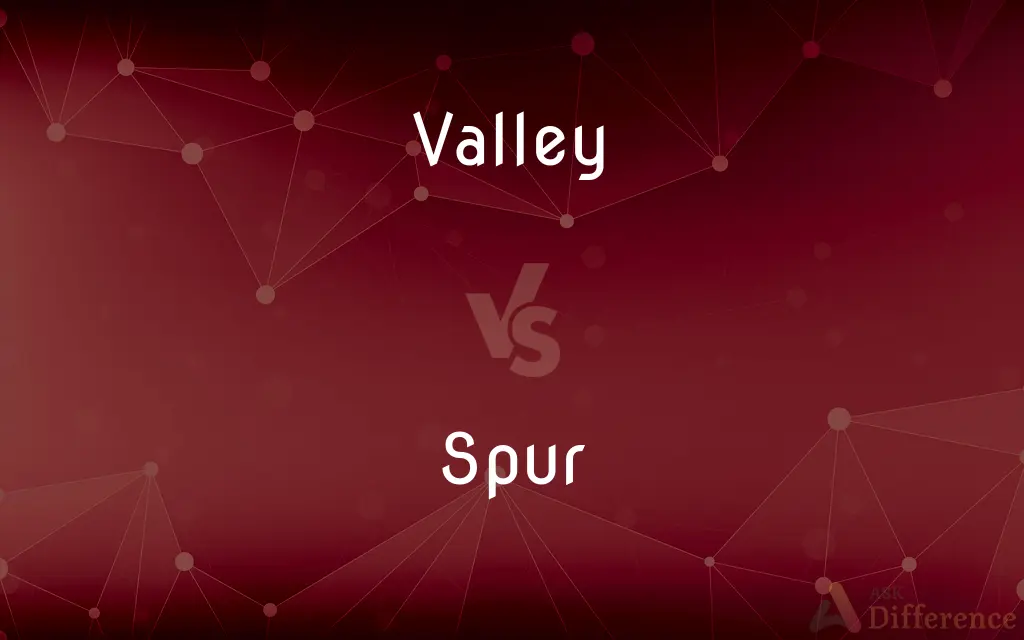Valley vs. Spur — What's the Difference?
By Tayyaba Rehman & Fiza Rafique — Updated on February 22, 2024
A valley is a low area between hills or mountains, often with a river running through it, while a spur is a projection or ridge extending out from a mountain or hill, typically sloping downwards.

Difference Between Valley and Spur
Table of Contents
ADVERTISEMENT
Key Differences
Valleys are formed by geological processes, such as the erosion caused by rivers or the movement of glaciers, which carve out wide, low areas between higher landforms. They are characterized by their elongated shape and can vary in size from small river valleys to extensive rift valleys.
Spurs, in contrast, are extensions of mountains or hills that project outward into the surrounding terrain. They are formed by the erosion of the surrounding land that leaves a ridge-like feature jutting out. Spurs are typically higher at their point of origin and slope downwards away from the mountain or hill, and they can serve as natural pathways or routes over rugged terrain.
Valleys are primarily defined by their low elevation and are considered negative landforms (formed by the removal of material), while spurs are positive landforms, constituted by the material left behind after erosion. The distinction between valleys and spurs lies in their formation and physical characteristics, with valleys acting as basins that collect water and sediments, and spurs standing out as elevated features in the landscape.
Valleys often serve as corridors for rivers and streams, providing routes for water to flow from higher to lower elevations. This hydrological feature makes valleys crucial in shaping the earth's surface, contributing to the development of fertile plains and supporting diverse ecosystems.
Spurs, on the other hand, offer unique vantage points and are significant in topography and navigation. They can influence local climate conditions by affecting wind patterns and precipitation distribution. In historical contexts, spurs have been strategic military locations due to their elevated positions and the natural defense they provide.
ADVERTISEMENT
Understanding the differences between valleys and spurs is essential in geography, environmental science, and land use planning, as it helps in interpreting landscape features, managing natural resources, and planning human activities in harmony with the natural environment.
Comparison Chart
Definition
A low area between hills or mountains, often containing a river.
A ridge or projection extending from a mountain or hill.
Formation
Erosion by water or glaciers, tectonic activity.
Erosion leaving a protruding ridge of land.
Characteristics
Elongated, low elevation, fertile due to water and sediment.
Slopes downwards from a mountain or hill, ridge-like.
Type of Landform
Negative (formed by removal of material).
Positive (constituted by material left behind).
Function/Role
Collects water and sediments, supports ecosystems and agriculture.
Provides natural pathways, influences climate, offers strategic advantages.
Compare with Definitions
Valley
Low area between mountains.
The valley was lush with a winding river.
Spur
Ridge projecting from a hill.
The hikers followed the spur to reach higher ground.
Valley
Elongated basin in the landscape.
The valley stretched for miles, surrounded by peaks.
Spur
Feature formed by erosion.
The spur stood out as a prominent feature in the terrain.
Valley
Depressed landform with a river.
Farming was prosperous in the fertile valley.
Spur
Strategic military location.
The ancient fort was built on a spur for defense.
Valley
Erosion-formed geographical feature.
The glacier-carved valley was a sight to behold.
Spur
Downward-sloping ridge.
The spur provided a natural path across the mountain.
Valley
Agricultural and settlement hub.
The valley was dotted with villages and farms.
Spur
Elevated landform extension.
Eagles nested along the rocky spur.
Valley
To form the shape of a valley.
Spur
A mountain that shoots from any other mountain, or range of mountains, and extends to some distance in a lateral direction, or at right angles.
Valley
A low area of land between hills or mountains, typically with a river or stream flowing through it.
The valley floor.
The Thames Valley.
Common Curiosities
Is agriculture possible on spurs?
While valleys are more commonly associated with agriculture due to their fertile land, some spurs may support farming on their slopes, depending on soil and climate conditions.
Can a river be found in a spur?
Rivers typically flow through valleys, not spurs, which are elevated ridges.
Are valleys always larger than spurs?
Valleys can vary greatly in size, but they are generally larger and more expansive than spurs, which are more localized features.
What distinguishes a valley from a spur in terms of formation?
Valleys are formed by erosion or tectonic activity creating low areas, while spurs are formed by erosion leaving a protruding ridge.
Can a valley exist without being surrounded by mountains or hills?
Valleys are typically defined by their location between higher elevations, but there are also rift valleys, formed by tectonic activity, that may not be surrounded by mountains or hills in the traditional sense.
How do valleys and spurs impact biodiversity?
Valleys often support diverse ecosystems due to water availability and fertile land, while spurs can create microclimates and habitats that support varied species, contributing to biodiversity in different ways.
What role do glaciers play in valley formation?
Glaciers can carve out valleys by eroding the land as they move, creating U-shaped valleys distinct from the V-shaped valleys formed by rivers.
Can valleys and spurs coexist in the same landscape?
Yes, valleys and spurs often coexist, with spurs sometimes extending into valleys, contributing to the complexity of the terrain.
What is the significance of valleys in hydrology?
Valleys play a crucial role in hydrology by directing water flow, contributing to river systems, and impacting flood dynamics.
How do spurs affect human activities?
Spurs can provide natural pathways over rough terrain and have been used historically for defense, influencing settlement and transportation.
Are spurs found in all mountain ranges?
Spurs are common in mountainous and hilly regions where erosion has shaped the landscape, but their presence and prominence can vary.
Do all valleys have rivers?
Many valleys have rivers, as they often form the lowest path for water to flow, but not all valleys contain rivers.
Can the erosion that forms spurs also create valleys?
Yes, the same erosional processes can contribute to the formation of both spurs and valleys, with valleys being the areas where material has been removed and spurs where material remains.
How are spurs used in navigation?
Spurs can serve as landmarks and natural compass points, helping in navigation over land.
How do valleys and spurs influence weather patterns?
Valleys can channel wind and affect local climate, while spurs can block or redirect prevailing winds, influencing weather patterns in their vicinity.
Share Your Discovery

Previous Comparison
Achilles vs. Agamemnon
Next Comparison
Page vs. SquireAuthor Spotlight
Written by
Tayyaba RehmanTayyaba Rehman is a distinguished writer, currently serving as a primary contributor to askdifference.com. As a researcher in semantics and etymology, Tayyaba's passion for the complexity of languages and their distinctions has found a perfect home on the platform. Tayyaba delves into the intricacies of language, distinguishing between commonly confused words and phrases, thereby providing clarity for readers worldwide.
Co-written by
Fiza RafiqueFiza Rafique is a skilled content writer at AskDifference.com, where she meticulously refines and enhances written pieces. Drawing from her vast editorial expertise, Fiza ensures clarity, accuracy, and precision in every article. Passionate about language, she continually seeks to elevate the quality of content for readers worldwide.













































